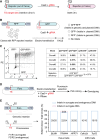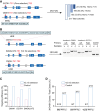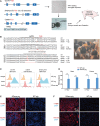Homozygous editing of multiple genes for accelerated generation of xenotransplantation pigs
- PMID: 40044221
- PMCID: PMC12047534
- DOI: 10.1101/gr.279709.124
Homozygous editing of multiple genes for accelerated generation of xenotransplantation pigs
Abstract
Although CRISPR-Cas-based genome editing has made significant strides over the past decade, achieving simultaneous homozygous gene editing of multiple targets in primary cells remains a significant challenge. In this study, we optimized a coselection strategy to enhance homozygous gene editing rates in the genomes of primary porcine fetal fibroblasts (PFFs). The strategy utilizes the expression of a surrogate reporter (eGFP) to select for cells with the highest reporter expression, thereby improving editing efficiency. For simultaneous multigene editing, we targeted the most challenging site for selection, whereas other target sites did not require selection. Using this approach, we successfully obtained single-cell PFF clones (three of 10) with seven or more homozygously edited genes, including GGTA1, CMAH, B4GALNT2, CD46, CD47, THBD, and GHR Importantly, cells edited using this strategy can be efficiently used for somatic cell nuclear transfer (SCNT) to generate healthy xenotransplantation pigs in <5 months, a process that previously required years of breeding or multiple rounds of SCNT.
© 2025 Duan et al.; Published by Cold Spring Harbor Laboratory Press.
Figures






References
MeSH terms
Substances
LinkOut - more resources
Full Text Sources
Research Materials
Miscellaneous
